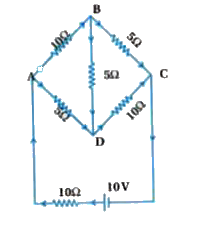A moving electron approaches another electron. What would be the change in the potential energy of this system ? Solution in Gujrati
Remains constant
Increases
Decreases
May increase or decrease
The correct Answer is:A, C
Potential energy for a system of two electron
U=k(−e)(−e)r
=ke2r
where ke2 is constant
∴U∝1r
∴ As r decreses U increases.
Topper's Solved these Questions
- BOOK - KUMAR PRAKASHANCHAPTER - ELECTROSTATIC POTENTIAL AND CAPACITANCEEXERCISE - Section D ( MCQs asked in Cometitive Exams )39videos
ELECTROSTATIC POTENTIAL AND CAPACITANCE
- BOOK - KUMAR PRAKASHANCHAPTER - ELECTROSTATIC POTENTIAL AND CAPACITANCEEXERCISE - Section C ( NCERT Exemplar Solution ) ( Long Answer Type Questions )12videos
ELECTROSTATIC POTENTIAL AND CAPACITANCE
- BOOK - KUMAR PRAKASHANCHAPTER - ELECTROMAGNETIC WAVESEXERCISE - BOARD.S QUESTION PAPER MARCH - 2020 (PART - B) SECTION - C5videos
ELECTROMAGNETIC WAVES
- BOOK - KUMAR PRAKASHANCHAPTER - MAGNETISM AND MATTEREXERCISE - SECTION D Multiple Choice Questions (MCQs) (MCQs asked in Competitive Exams) MCQs asked in Board Exam and GUJCET7videos
MAGNETISM AND MATTER
Similar Questions
Capacitance of a capacitor 100 μ F. The work is done for depositing chargc 8×10−18 C on it will be .........
02:41View SolutionFind the equation of the equipotential for an infinite cylinder of radius r0 carrying charge of linear density λ.
01:50View SolutionDetermine the current in each branch of the given network.
 01:57View Solution
01:57View SolutionAt a place on earth the vertical component of earth's magnetic field is √3 times its horizontal component. The angle of dip at this place is …...
04:13View SolutionThe total energy of an electron in the first excited state of hydrogen atom is -3.4 eV. (a) What is kinetic energy of electron in this state? (ii) What is potential energy of electron in this state? (c) Which of the answers above would change if the choice of zero of potential energy is changed?
02:16View SolutionWhen a proton approaches another fixed proton, what happens to :
(a) the kinetic energy of the approaching proton
(b) the electric potential energy potential energy of the system and
(c ) the total energy of the system ?02:47View Solutionएक इलेक्ट्रॉन को दूसरे इलेक्ट्रॉन के अधिक समीप लाने पर निकाय की वैधुत स्थितिज ऊर्जा
01:54View SolutionIn bringing an electron towards another electron, the electrostatic potential energy of the system
02:26View SolutionWhat happens to electrostatic potential energy of a two electron system, if one electrons brought towards another electron?
View SolutionThe total energy of an electron in the first excited state of the hydrogen atom is about –3.4 eV. (a) What is the kinetic energy of the electron in this state? (b) What is the potential energy of the electron in this state? (c) Which of the answers above would change if the choice of the zero of potential energy is changed?
04:44View Solutionजब एक गतिशील इलेक्ट्रॉन दूसरे स्थिर इलेक्ट्रॉन के पास आता है तब इसकी गतिज ऊर्जा और स्थितिज ऊर्जा क्रमशः …………..और……….. है।
01:56View SolutionThe total energy of an electron in the first excited state of the hydrogen atom is about –3.4 eV.
(a) What is the kinetic energy of the electron in this state?
(b) What is the potential energy of the electron in this state?
(c) Which of the answers above would change if the choice of the zero of potential energy is changed?01:14View SolutionThe total energy of an electron in the first excited state of the hydrogen atom is about - 3.4 eV.
(a) What is the kinetic energy of the electron in this state ?
(b) What is the potential energy of the electron in this state ?
Which of the answers above would change if the choice of the zero of potential energy is changed ?View SolutionThe total energy of an electron in the first excited state of hydrogen atom is -3.4 eV.
(a) What is kinetic energy of electron in this state?
(ii) What is potential energy of electron in this state?
(c) Which of the answers above would change if the choice of zero of potential energy is changed?02:29View SolutionWould electrons move from higher potentials to lower potentials or vice-versa?
00:58View Solution

